Applied Mathematics
Vol.3 No.12(2012), Article ID:25794,12 pages DOI:10.4236/am.2012.312276
Some Approximation in Cone Metric Space and Variational Iterative Method
School of Science, Southwest University of Science and Technology, Mianyang, China
Email: chenning783@163.com, chenning@swust.edu.cn
Received September 23, 2012; revised October 23, 2012; accepted November 1, 2012
Keywords: Cone Metric Space; Common Fixed Point; Effective Variation Iteration Method; Integral-Differential Equation
ABSTRACT
In this paper, we give some new results of common fixed point theorems and coincidence point case for some iterative method. By using of variation iteration method and an effective modification of He’s variation iteration method discusses some integral and differential equations, we give out some new conclusion and more new examples.
1. Introduction
Fixed point theory has fascinated many researchers since 1922 with the celebrated Banach’s fixed point theorem. There exist a fast literature on the topic and this is a very active field of research at present (See [1-7]).
By using same definition and meaning in stating is also looking in [2] and [3] etc. we introducing the following results for needing. For convenience, the authors give the following definition and lemma (see the proof of theorem 3 [2])
Let  always be a real Banach space, and
always be a real Banach space, and  be the subset of
be the subset of  is called a cone, if and only if:
is called a cone, if and only if:
(i)  is closed, nonempty, and
is closed, nonempty, and 
(ii) 
(iii) 
Given a cone we define a partial ordering
we define a partial ordering  with respect to
with respect to  by
by  if and only if
if and only if 
We shall write  to indicate
to indicate  but
but  while
while  implies
implies  int
int denotes the interior of
denotes the interior of .
.
Definition 1.1 Let  be a non-empty set in
be a non-empty set in , and suppose the mapping
, and suppose the mapping  satisfies:
satisfies:
(i)  for any
for any  and
and 
(ii)  for all
for all 
(iii)  for all
for all 
Then ![]() is cone distance on
is cone distance on 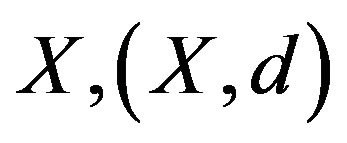 is called a cone metric space.
is called a cone metric space.
It is obvious that cone metric space generalize the metric spaces.
Definition 1.2 Let  is said to be a complete cone metric space, if every Cauchy sequence is convergent in
is said to be a complete cone metric space, if every Cauchy sequence is convergent in 
Let  be a metric space. We denote by
be a metric space. We denote by  the family of non-empty closed bounded subset of
the family of non-empty closed bounded subset of  Let
Let  be the Hausdorff metric on
be the Hausdorff metric on . That is for
. That is for

where  is the distance from point
is the distance from point ![]() to the sub-set
to the sub-set  An element
An element  is said to be a fixed point of a multi-valued mapping
is said to be a fixed point of a multi-valued mapping 
Lemma 1.3 Suppose that  be a cone metric space and the mapping
be a cone metric space and the mapping  hold the sequence
hold the sequence  in
in  satisfying the following conditions:
satisfying the following conditions:

and that is

Then the sequence 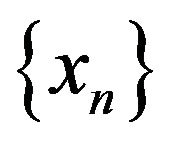 is a Cauchy sequence in
is a Cauchy sequence in .
.
2. Several Common Fixed Point Theorems
In recent years, the fixed point theory and application has rapidly development. Huang and Zhang [2] introduced the concept of a cone metric space that a element in Banach space equipped with a cone which induces a nature order partial order. In the same work, they investigated the convergence and that inequality and they extend the contractive principle to in partial order set s with some applications to matrix equations and common solution of integral equations.
Such theorems are very important tools for proving the existence and eventually the uniqueness of the solutions to various mathematical models (integral and partial differential equations, variations inequalities etc.).
First, we state following some extend conclusion ([3, 4]). Next, authors consider the variation iterative method to some integral and differential equations, and effective method ([5-8]) for examples and numerical test as some Fig case.
Now we first give common fixed point Theorem in similar method for two operators to extend Theorem 2.1 [2] with one operator case. Assume that  be a complete cone metric space.
be a complete cone metric space.
Theorem 2.1 Let  be a complete cone metric space,
be a complete cone metric space,  a normal cone with normal constant
a normal cone with normal constant  Suppose that mappings
Suppose that mappings  satisfies the Contractive condition
satisfies the Contractive condition
 (2.1)
(2.1)
for each  where
where  is a constant
is a constant  Then
Then ![]() has a unique common fixed point in
has a unique common fixed point in  And so for any
And so for any 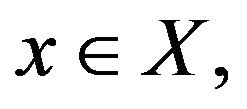 the iterative sequence
the iterative sequence  converges to the fixed point.
converges to the fixed point.
Corollary 2.2 Let  and
and 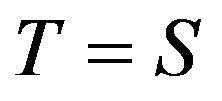 then we obtain that theorem 2.1 in [2].
then we obtain that theorem 2.1 in [2].
In the same way, authors can extend theorem 4 [2], and omit again these stating.
3. Some Notes of Common Fixed Point
The common fixed point theorems for two operators in cone metric space are given in [3]. By using of needing same definition and as same results in it, we consider fixed point theorem in cone metric space to complete and extending the Theorem 1 in it.
Theorem A (See Theorem 1 [3]) Assume that  be a complete cone metric space. Let mappings
be a complete cone metric space. Let mappings  satisfying following Lipchitz conditions for any
satisfying following Lipchitz conditions for any 
 (3.0)
(3.0)
where  are nonnegative real value functions on
are nonnegative real value functions on  such that
such that

and that

Then there is a unique common fixed point in  for
for ![]() and
and  and for any
and for any  the iterative sequence
the iterative sequence  convergent to the common fixed point of
convergent to the common fixed point of ![]()

Remark in [3], the example 2 illustrate this effect of meanings with this Theorem (non-expansion mapping, not contractive case that have uniqueness common fixed point). Look for multiple-value mappings in some case [5].
We can easy note Theorem A. Now we give complete this fixed point problem below.
Theorem 3.1 Same as the assume of theorem 1 [3]. Let  be a complete cone metric space, and there exists positive integer
be a complete cone metric space, and there exists positive integer  and mappings
and mappings  satisfying following Lipchitz conditions for any
satisfying following Lipchitz conditions for any 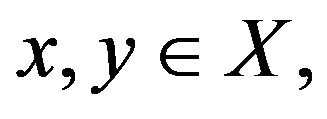 that is satisfy following inequality such that
that is satisfy following inequality such that
 (3.1)
(3.1)
where  are non-negative real functions on
are non-negative real functions on 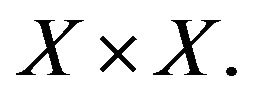 If it holds,
If it holds, 
Then there is a unique common fixed point in  for
for .
.
Proof By the proof of theorem 1 [3] that we known that  and
and  has a unique common fixed point
has a unique common fixed point  and
and  from
from

then  is also common fixed point of
is also common fixed point of  and
and  Hence, we have
Hence, we have  by the uniqueness of them. In the same way, we know that
by the uniqueness of them. In the same way, we know that  that is,
that is,  This
This ![]() is a common fixed point of
is a common fixed point of , and
, and

We have 
On the other hand, if  then clearly,
then clearly,  in the same way, we know
in the same way, we know ![]() which a contradiction. So, we complete the proof of this theorem.
which a contradiction. So, we complete the proof of this theorem.
Theorem 3.2 Let  be a complete cone metric space, and mappings
be a complete cone metric space, and mappings  satisfying following Lipchitz conditions for any
satisfying following Lipchitz conditions for any 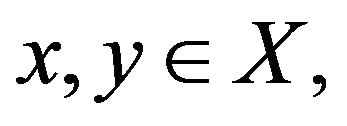 that is satisfy following inequality (
that is satisfy following inequality ( nonnegative real constant)
nonnegative real constant)
 (3.2)
(3.2)
and

If  have not common fixed point each other, then the
have not common fixed point each other, then the ![]() exist at least
exist at least ![]() number fixed points in
number fixed points in 
Proof By the theorem 1 [3], we known that ![]() and
and ![]() has a unique common fixed point
has a unique common fixed point  that is
that is  and that in the same way,
and that in the same way,

Then S have at least ![]() number fixed points.
number fixed points.
Corollary 3.3 Let  more positive integer cases in theorem 3.1.
more positive integer cases in theorem 3.1.
Remark 3.4 (see corollary 5 [3]) Assume that 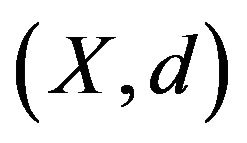 be complete cone metric space, and mappings
be complete cone metric space, and mappings  satisfy following condition (
satisfy following condition ( non-negative real constant):
non-negative real constant):
 (3.3)
(3.3)
And

then ![]() must have uniqueness common fixed point, and for any
must have uniqueness common fixed point, and for any  iterative sequence
iterative sequence  convergent to the common fixed point
convergent to the common fixed point

Here example 2 in [5] for non-expansion mappings, also have common fixed point case with important meanings.
4. Common Fixed Point of Four Mappings
Many authors have extended the contraction mapping principle in difference direction. Some extension of Banach’s fixed point theorem through the rational expression form with it’s inequality. The purpose of this section, is to establish some common fixed point theorem for four mappings in this space.
Theorem 4.1 Assume that  be a complete cone metric space, and mappings
be a complete cone metric space, and mappings  continuous and satisfying following conditions for any
continuous and satisfying following conditions for any

and that inequality
 (4.1)
(4.1)
Then  have a unique common fixed point.
have a unique common fixed point.
Proof Let  be an arbitrary point of
be an arbitrary point of  and from
and from  we can choose a point
we can choose a point such that
such that  Also
Also  we can choose a point
we can choose a point  such that
such that  In general, we can Choose
In general, we can Choose  and
and  define a sequence
define a sequence  in
in  as follows,
as follows,

Now, by (4.1) we have that
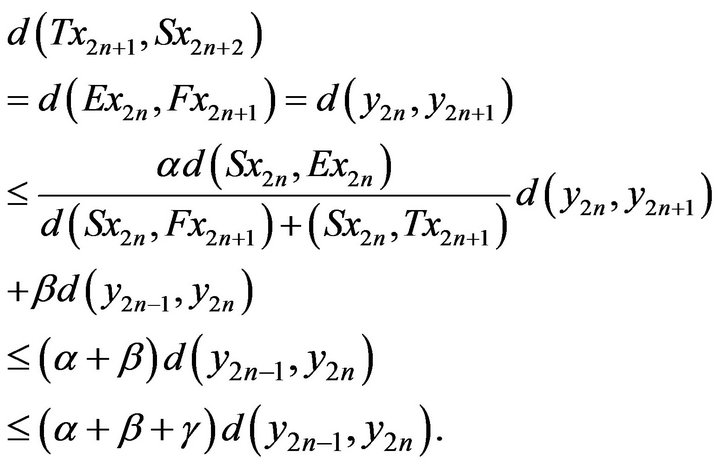
Similarly, we have

which implies that

Hence, it is well know that  is Cauchy sequence. From the
is Cauchy sequence. From the  is complete, then there exists
is complete, then there exists  such that the
such that the  convergences to
convergences to ![]() in
in  Since
Since  and
and  are subsequences of
are subsequences of  then it will convergence to same point u.
then it will convergence to same point u.
Next, from these  are continuous maps, we can obtain following results
are continuous maps, we can obtain following results

It follows from  then we have
then we have
 and we get
and we get  In the same reason,
In the same reason,

we again obtain  By (4.1), if
By (4.1), if  then
then

this is a contradiction. Hence, we have that

Let  then we obtain that
then we obtain that

and

By (4.1), if  then
then

we get 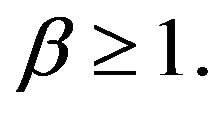
It is a contradiction. Thus, 
Similarly,

we get 
It is also a contradiction. Therefore, 
By (4.1), if  then
then

also a contradiction. Thus, we have

then this implies  for common fixed point of
for common fixed point of .
.
(Uniqueness) Let two points  be the difference common fixed point of
be the difference common fixed point of .
.
By (4.1), we have

A contradiction in the above same reason, then this implies the uniqueness of common fixed point of .
.
Remarks
(i) As  we obtain special case.
we obtain special case.
(ii)  (Identity map),
(Identity map),  we get some special case.
we get some special case.
Theorem 4.2 Assume that  be a complete cone metric space. Same as theorem 4.1, and satisfies these conditions below
be a complete cone metric space. Same as theorem 4.1, and satisfies these conditions below


for any
 (4.2)
(4.2)
Then  have a unique common fixed point.
have a unique common fixed point.
Proof By theorem 4.1, we known that there is a unique fixed point ![]() in
in  and
and 
Obviously,  This completes the proof of theorem 4.2.
This completes the proof of theorem 4.2.
5. Some Notes for Multi-Valued Mappings
According the direction of [5], we give out some coincidence point theorem of maps to extend theorem 2.1 and theorem 2.3 [5].
Let  be a strictly increasing function such that
be a strictly increasing function such that
(i) 
(ii)  for each
for each 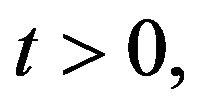
(iii) 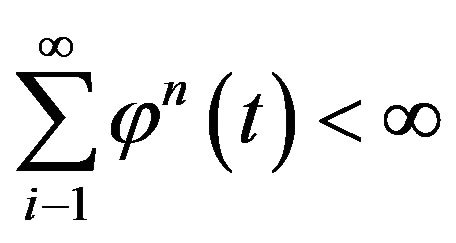 for each
for each 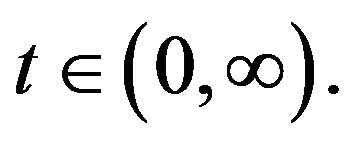
Now, we can easy obtain following theorems.
Theorem 5.1 Let 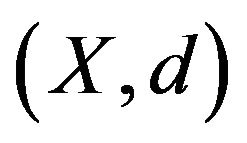 be a complete metric space and
be a complete metric space and  be multi-valued maps
be multi-valued maps
 satisfying for each
satisfying for each 

where
 (5.1)
(5.1)
If  have not common fixed point each other, then there exist at least
have not common fixed point each other, then there exist at least ![]() number fixed points in
number fixed points in 
Proof From theorem 2.1 [5], we known there exist  in
in  such that
such that  again for
again for  in
in 
The same way,

Since  not equality each other, then S have at least
not equality each other, then S have at least ![]() number fixed point. This completes the proof.
number fixed point. This completes the proof.
Theorem 5.2 Let  be a complete metric space and
be a complete metric space and  be multi-valued maps
be multi-valued maps
 and
and  be a map satisfying
be a map satisfying
(i) 
(ii)  is complete(iii) there exists a function
is complete(iii) there exists a function  such that
such that
 for every
for every  (5.2)
(5.2)
And for each 
 (5.3)
(5.3)
If  and
and  have not coincidence point each other, then the
have not coincidence point each other, then the  and
and  at least exist
at least exist ![]() number coincidence points in
number coincidence points in 
Proof From theorem 2.3 [5], we known there exist coincidence point  in
in  such that
such that  in the same way, the coincidence point
in the same way, the coincidence point  in
in 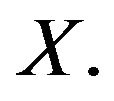 with
with

Since

not equality each other, therefore ![]() and
and  have at least
have at least ![]() number coincidence point. That is,
number coincidence point. That is,

Then this completes the proof.
Corollary 5.3 Let  be a complete metric space and
be a complete metric space and  be multi-valued maps
be multi-valued maps
 and
and  be a map satisfying
be a map satisfying
(i) 
(ii)  is complete(iii)
is complete(iii)  for each
for each  where
where  such that
such that  for every
for every 
If  have not coincidence point each other, then
have not coincidence point each other, then 
If we take  we easy get these conclusion below, where
we easy get these conclusion below, where  is the identity map on
is the identity map on 
Corollary 5.4 Let  be a complete metric space and
be a complete metric space and  be multi-valued maps
be multi-valued maps  and satisfying for each
and satisfying for each

where  such that
such that  for every
for every 
If  have not common fixed point each other, then the
have not common fixed point each other, then the ![]() and
and ![]() exist at least
exist at least![]() number points in
number points in 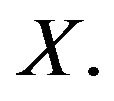 That is case
That is case

Corollary 5.5 When , for each
, for each  Then we get also similar conclusion case:
Then we get also similar conclusion case: 
6. Solution of Integral Equation by VIM
Recently, the variation iteration method (VIM) has been favorably applied to some various kinds of nonlinear problems, for example, fractional differential equations, nonlinear differential equations, nonlinear thermo elasticity elasticity, nonlinear wave equations.
In this section, we apply the variation iteration method (simple writing VIM) to Integral-differential equations below (see [6,7]). To illustrate the basic idea of the method, we consider:

The basic character of the method is to construct functional for the system, which reads:

which can be identified optimally via variation theory,  is the nth approximate solution, and
is the nth approximate solution, and  denotes a restricted variation, i.e.
denotes a restricted variation, i.e.  There is a iterative formula:
There is a iterative formula:

of this equation
 (*)
(*)
Theorem 6.1 (see theorem 3.1 [6]) Consider the iteration scheme  and
and
 . (6.1)
. (6.1)
Now, for  to construct a sequence of Successive iterations that for the
to construct a sequence of Successive iterations that for the  for solution of integral Equation
for solution of integral Equation .
.
In addition, we assume that

and ![]() then if
then if  the above iteration converges in the norm of
the above iteration converges in the norm of ![]() to the solution of integral equation
to the solution of integral equation .
.
Corollary 6.2 If  and
and

then assume ![]() if
if  the above iteration converges in the norm of
the above iteration converges in the norm of ![]() to the solution of integral equation
to the solution of integral equation .
.
Corollary 6.3 If  and
and

then assume ![]() if
if 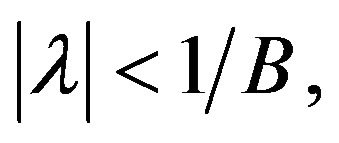 the above iteration converges in the norm of
the above iteration converges in the norm of ![]() to the solution of integral Equation
to the solution of integral Equation .
.
Example 6.4 Consider that integral equation
 (6.2)
(6.2)
where

then if  (See Figure 1(a)) then the iterative
(See Figure 1(a)) then the iterative  that convergent the solution of Equation (6.2) by corollary 6.2 of theorem 6.1. Therefore, we check that
that convergent the solution of Equation (6.2) by corollary 6.2 of theorem 6.1. Therefore, we check that

From (6.1), we have that

Let

and

(See Figure 1(b), when n = 4).
The exact solution ![]() Then we obtain exact solution below
Then we obtain exact solution below

Remark The exact solution ![]() and approximate solution
and approximate solution 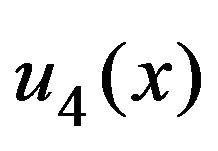 of Example 6.4 (See Figure 1(c)).
of Example 6.4 (See Figure 1(c)).
Example 6.5 We consider that integral equation
 (6.3)
(6.3)
From (6.1), we have that

We take

The exact solution ![]() then we obtain exact solution below
then we obtain exact solution below

By corollary 6.2 of Theorem 6.1, where that

Then the iterative sequence is convergent to the exact solution of the Equation (6.3).
In fact,

then if  the iterative sequence is convergent the solution of Equation (6.3).
the iterative sequence is convergent the solution of Equation (6.3).
Example 6.6 Consider that integral equation (
 positive integer),
positive integer),
 (6.4)
(6.4)
where  and we have that
and we have that

We can take that
 (a)
(a) (b)
(b) (c)
(c)
Figure 1. By Matlab in numerable test. (a) The figure expresses exact solution u(x) for Example 6.4; (b) The figure expresses approximate solution u4(x) for the solution u(x) of Example 6.4; (c) The figure expresses absolute error for Example 6.4.
for Example 6.4.
(k-positive integer), and

Inductively, we have

Then by Theorem 6.1 and simple computation, we obtain that

then if  the iterative is convergent the solution of integral equation (6.4) (Similar as examples case in [6, 7]).
the iterative is convergent the solution of integral equation (6.4) (Similar as examples case in [6, 7]).
7. Some Effective Modification and Numerical Test for [8]
In this section, we apply the effective modification method of He’s VIM to solve some integral-differential equations. In [6-8] by the variation iteration method (VIM ) simulate the system of this form

To illustrate its basic idea of the method, we consider the following general nonlinear system

the highest derivative and is assumed easily invertible,  is a linear differential operator of order less than,
is a linear differential operator of order less than, 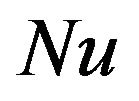 represents the nonlinear terms, and
represents the nonlinear terms, and ![]() is the source term. Applying the inverse operator
is the source term. Applying the inverse operator  to both sides of above equation, we obtain
to both sides of above equation, we obtain

The variational iteration method (VIM) proposed by Ji-Huan He (see [6-8] recently has been intensively studied by scientists and engineers. the references cited therein) is one of the methods which have received much concern. It is based on the Lagrange multiplier and it merits of simplicity and easy execution. Unlike the traditional numerical methods. Along the direction and technique in [4,8] we may get more examples below.
Example 7.1 (similar as example in [8]) Consider the following nonlinear Fredholm integral equation
 (7.1)
(7.1)
Applying the inverse operator  to both side of Equation (7.1), yields:
to both side of Equation (7.1), yields:

from 
So,

Inductively,

Then  is exact solution of (7.1). The numerical results are shown in Figure 2.
is exact solution of (7.1). The numerical results are shown in Figure 2.
Example 7.2 Consider the following Volterra-Fredholm integral-differential equation
 (7.2)
(7.2)
Similar as example1 in this way, we easy get this solution.
According to the method, we divide into two parts defined
into two parts defined and
and

By calculating this

So, we have

In fact, in this way

and

Writing

therefore, we have

Inductively,

And 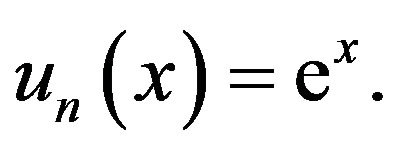 Hence the
Hence the  is the exact solution of (7.2).
is the exact solution of (7.2).
Example 7.3 Consider the following integral-differential equation
 (7.3)
(7.3)
where  In similar example1, we easy have it .
In similar example1, we easy have it .
According to the method, we divide into two parts defined by
into two parts defined by

Figure 2. Figures of exact solution u(x) for Example 7.1.

Taking  then we have
then we have

where 
And the processes,

Thus,  then
then  is the exact solution of (7.3) by only one iteration leads to a solution. The numerical results are shown in Figure 3.
is the exact solution of (7.3) by only one iteration leads to a solution. The numerical results are shown in Figure 3.
Example 7.4 (See example 2 in [8]) Consider the following partial differential equation
 (7.4)
(7.4)
Let that integer The modified methods:
The modified methods:
Applying the inverse operator to both sides of (7.4) yields

where 
Here, we divide  into two parts defined by
into two parts defined by

Using the relation  we obtain
we obtain

and so on

Hence,  is the exact solution of (7.4) and by only one iteration leads to that exact solution. Taking
is the exact solution of (7.4) and by only one iteration leads to that exact solution. Taking  that is example 2 in [8].
that is example 2 in [8].
The numerical results are shown in Figure 4.
Remark 7.5 Some solving integral-differential equations by VIM may see [9], and that some random Altman type inequality for fixed point results see [10].
The fixed point results of Multi-value mapping are also discussed in [11].
Remark 7.6 By [12], the authors consider the mixed problem for non-linear Burgers equation:
 (7.5)
(7.5)
The authors point out the problem describes physic phenomenon of motive quality and conservation of law in dynamic problem, it is important model in flow mechanics. Where ![]() express the velocity of flow body,
express the velocity of flow body,

Figure 3. Figures of exact solution u(x) for Example 7.3.




Figure 4. Figures of exact solution u(x) for example 7.4. (where parameters taking as ).
).
and ![]() express the constant of motive flow body,
express the constant of motive flow body,
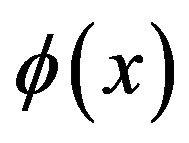 -initial function.
-initial function.
Burger’s equation has attracted much attention. The approximation solution for this Burger’s equation is also interesting tasks.
8. Concluding Remarks
In this Letter, we give out new fixed point theorems in cone metric space and apply the variation iteration method to integral-differential equation, and extend some results in [3,6-8]. The obtained solution shows the method is also a very convenient and effective for some various non-linear integral and differential equations, only one iteration leads to exact solutions.
Recently, the impulsive differential delay equation and stochastic schrodinger equation is also a very interesting topic, and may look [11] etc.
9. Acknowledgements
This work is supported by the Natural Science Foundation (No.07ZC053) of Sichuan Education Bureau and the key program of Science and Technology Foundation (No.07zx2110) of Southwest University of Science and Technology.
The authors would like to thank the reviewers for the useful comments and some more better results.
REFERENCES
- D. J. Guo and V. Lakshmikantham, “Nonlinear Problems in Abstract Cones,” Academic Press, Inc., Boston, New York, 1988.
- L. G. Hung and X. Zhang, “Cone Metric Spaces and Fixed Point Theorems of Contractive Mappings,” Journal of Mathematical Analysis and Applications, Vol. 332, No. 2, 2007, pp. 1468-1476. doi:10.1016/j.jmaa.2005.03.087
- X. Zhang, “Common Fixed Point Theorem of Lipschitz Type Mappings on Cone Metric Space,” Acta Mathematica Sinica, Chinese Series, Vol. 53, No. 6, 2010, pp. 1139-1148.
- H. Avdi, H. K. Nashine, B. Samet and H. Yazidi, “Coincidence and Common Fixed Point Results in Partial Ordered Cone Metric Spaces and Applications to Integral Equations,” Nonlinear Analysis, Vol. 74, No. 17, 2011, pp. 6814-6825. doi:10.1016/j.na.2011.07.006
- S. H. Cho and M. S. Kim, “Fixed Point Theorems for General Contractive Multi-Valued Mappings,” Applied Mathematics Information, Vol. 27, No. 1-2, 2009, pp. 343-350.
- N. Chen and J. Q. Chen, “New Fixed Point Theorems for 1-Set-Contractive Operators in Banach Spaces,” Journal of Fixed Point Theory and Applications, Vol. 6, No. 3, 2011, pp. 147-162.
- N. Chen and J. Q. Chen, “Operator Equation and Application of Variational Iterative Method,” Applied Mathematics, Vol. 3, No. 8, 2012, pp. 857-863. doi:10.4236/am.2012.38127
- A. Ghorbani and J. Sabaeri-Nadjafi, “An Effective Modification of He’s Variational Iteration Method,” Nonlinear Analysis: Real World Applications, Vol. 10, No. 5, 2009, pp. 2828-2833. doi:10.1016/j.nonrwa.2008.08.008
- S. Q. Wang and J. H. He, “Variational Iterative Method for Solving Integral-Differential Equations,” Physics Letters A, Vol. 367, No. 3, 2007, pp. 188-191. doi:10.1016/j.physleta.2007.02.049
- N. Chen, B. D. Tian and J. Q. Chen, “Some Random Fixed Point Theorems and Random Altman Type Inequality,” International Journal of Information and Systems Sciences, Vol. 7, No. 1, 2011, pp. 83-91.
- S. Jain and V. H. Badshah, “Fixed Point Theorem of Multi-Valued Mappings in Cone Metric Spaces,” International Journal of Mathematical Archive, Vol. 2, No. 12, 2011, pp. 2753-2756.
- J. Biazar and H. Aminikahah, “Exact and Numerical Solutions for Non-Linear Burgers’s Equation by VIM,” Mathematical and Computer Modeling, Vol. 49, No. 7-8, 2009, pp. 1394-1400. doi:10.1016/j.mcm.2008.12.006

